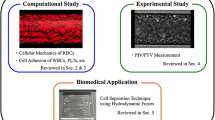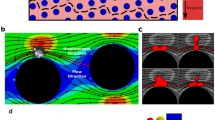Abstract
We investigate the biophysical characteristics of healthy human red blood cells (RBCs) traversing microfluidic channels with cross-sectional areas as small as 2.7 × 3 μm. We combine single RBC optical tweezers and flow experiments with corresponding simulations based on dissipative particle dynamics (DPD), and upon validation of the DPD model, predictive simulations and companion experiments are performed in order to quantify cell deformation and pressure–velocity relationships for different channel sizes and physiologically relevant temperatures. We discuss conditions associated with the shape transitions of RBCs along with the relative effects of membrane and cytosol viscosity, plasma environments, and geometry on flow through microfluidic systems at physiological temperatures. In particular, we identify a cross-sectional area threshold below which the RBC membrane properties begin to dominate its flow behavior at room temperature; at physiological temperatures this effect is less profound.





Similar content being viewed by others
References
Abkarian, M., M. Faivre, and H. A. Stone. High-speed microfluidic differential manometer for cellular-scale hydrodynamics. Proc. Natl. Acad. Sci. USA 103:538–542, 2006.
Antia, M., T. Herricks, and P. K. Rathod. Microfluidic modeling of cell–cell interactions in malaria pathogenesis. PLoS Pathog. 3:939–948, 2007.
Bagchi, P., P. C. Johnson, and A. S. Popel. Computational fluid dynamic simulation of aggregation of deformable cells in a shear flow. J. Biomech. Eng. Trans. ASME 127:1070–1080, 2005.
Boey, S. K., D. H. Boal, and D. E. Discher. Simulations of the erythrocyte cytoskeleton at large deformation. i. microscopic models. Biophys. J. 75:1573–1583, 1998.
Canham, P. B., and A. C. Burton. Distribution of size and shape in populations of normal human red cells. Circul Res. 22:405–422, 1968.
Chien, S. Red cell deformability and its relevance to blood flow. Annu. Rev. Physiol. 49:177–192, 1987.
Danker, G., P. M. Vlahovska, and C. Misbah. Vesicles in Poiseuille flow. Phys. Rev. Lett. 102:148102, 2009.
Evans, E. A., and R. M. Hochmuth. Membrane viscoelasticity. Biophys. J. 16:1–11, 1976.
Fedosov, D., B. Caswell, and G. E. Karniadakis. A multiscale red blood cell model with accurate mechanics, rheology and dynamics. Biophys. J. 98:2215–2225, 2010.
Frank, R. S., and R. M. Hochmuth. The influence of red cell mechanical properties on flow through single capillary-sized pores. J. Biomech. Eng. Trans. ASME 110:155–160, 1988.
Groot, R. D., and P. B. Warren. Dissipative particle dynamics: bridging the gap between atomistic and mesoscopic simulation. J. Chem. Phys. 107:4423–4435, 1997.
Herrmann, A., and P. M. Müller. Correlation of the internal microviscosity of human erythrocytes to the cell volume and the viscosity of hemoglobin solutions. Biochim. Biophys. Acta 885:80–87, 1986.
Higgins, J. M., D. T. Eddington, S. N. Bhatia, and L. Mahadevan. Sickle cell vasoocclusion and rescue in a microfluidic device. Proc. Natl. Acad. Sci. USA 104:20496–20500, 2007.
Hochmuth, R. M., R. N. Marple, and S. P. Sutera. Capillary blood flow. I. erythrocyte deformation in glass capillaries. Microvasc. Res. 2:409–419, 1970.
McWhirter, J. L., H. Noguchi, and G. Gompper. Flow-induced clustering and alignment of vesicles and red blood cells in microcapillaries. Proc. Natl. Acad. Sci. USA 106:6039–6043, 2009.
Mills, J. P., M. Diez-Silva, D. J. Quinn, M. Dao, M. Lang, K. S. Tan, C. T. Lim, G. Milon, P. H. David, O. Mercereau-Puijalon, S. Bonnefoy, and S. Suresh. Effect of plasmodial resa protein on deformability of human red blood cells harboring plasmodium falciparum. Proc. Natl. Acad. Sci. USA 104:9213–9217, 2007.
Mills, J. P., L. Qie, M. Dao, C. T. Lim, and S. Suresh. Nonlinear elastic and viscoelastic deformation of the human red blood cell with optical tweezers. MCB 1:169–180, 2004.
Mohandas, N., and E. Evans. Mechanical properties of the red cell membrane in relation to molecular structure and genetic defects. Annu. Rev. Biophys. Biomol. Struct. 23:787–818, 1994.
Noguchi, H., and G. Gompper. Shape transitions of fluid vesicles and red blood cells in capillary flows. Proc. Natl. Acad. Sci. USA 102:14159–14164, 2005.
Park, Y., M. Diez-Silva, G. Popescu, G. Lykotrafitis, W. Choi, M. S. Feld, and S. Suresh. Refractive index maps and membrane dynamics of human red blood cells parasitized by plasmodium falciparum. Proc. Natl. Acad. Sci. USA 105:13730–13735, 2008.
Pivkin, I. V., and G. E. Karniadakis. Accurate coarse-grained modeling of red blood cells. Phys. Rev. Lett. 101:118105, 2008.
Popel, A., and P. Johnson. Microcirculation and hemorheology. Annu. Rev. Fluid. Mech. 37:43–69, 2005.
Pozrikidis, C. Numerical simulation of blood flow through microvascular capillary networks. Bull. Math. Biol. 71:1520–1541, 2009.
Secomb, T. W., and R. Hsu. Analysis of red blood cell motion through cylindrical micropores: effects of cell properties. Biophys. J. 71:1095–1101, 1996.
Shevkoplyas, S., T. Yoshida, S. Gifford, and M. Bitensky. Direct measurement of the impact of impaired erythrocyte deformability on microvascular network perfusion in a microfluidic device. Lab Chip 6:914–920, 2006.
Suresh, S., J. Spatz, J. Mills, A. Micoulet, M. Dao, C. Lim, M. Beil, and T. Seufferlein. Connections between single-cell biomechanics and human disease states: gastrointestinal cancer and malaria. Acta Biomater. 1:15–30, 2005.
Sutton, N., M. C. Tracey, I. D. Johnston, R. S. Greenaway, and M. W. Rampling. A novel instrument for studying the flow behaviour of erythrocytes through microchannels simulating human blood capillaries. Microvasc. Res. 53:272–281, 1997.
Waugh, R., and E. A. Evans. Thermoelasticity of red blood cell membrane. Biophys. J. 26:115–131, 1979.
Weinbaum, S., J. M. Tarbell, and E. R. Damiano. The structure and function of the endothelial glycocalyx layer. Annu. Rev. Biomed. Eng. 9:121–167, 2007.
Acknowledgments
This work was done as a part of the interdisciplinary research group on Infectious Diseases which is supported by the Singapore MIT Alliance for Research and Technology (SMART) and was also partially supported by NIH/NHLBI award number R01HL094270. This work made use of MRSEC Shared Facilities supported by the National Science Foundation under Award Number DMR-0213282. Simulations were performed using the NSF NICS supercomputing center.
Author information
Authors and Affiliations
Corresponding author
Additional information
Associate Editor Aleksander S. Popel oversaw the review of this article.
Electronic supplementary material
Below is the link to the electronic supplementary material.
Rights and permissions
About this article
Cite this article
Quinn, D.J., Pivkin, I., Wong, S.Y. et al. Combined Simulation and Experimental Study of Large Deformation of Red Blood Cells in Microfluidic Systems. Ann Biomed Eng 39, 1041–1050 (2011). https://doi.org/10.1007/s10439-010-0232-y
Received:
Accepted:
Published:
Issue Date:
DOI: https://doi.org/10.1007/s10439-010-0232-y




